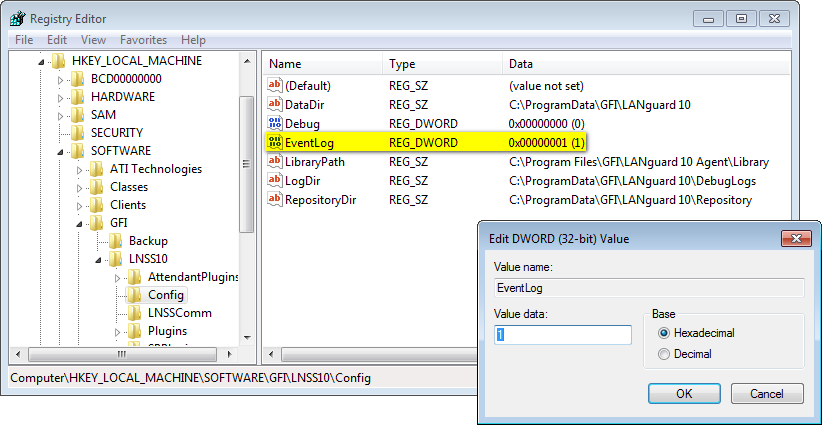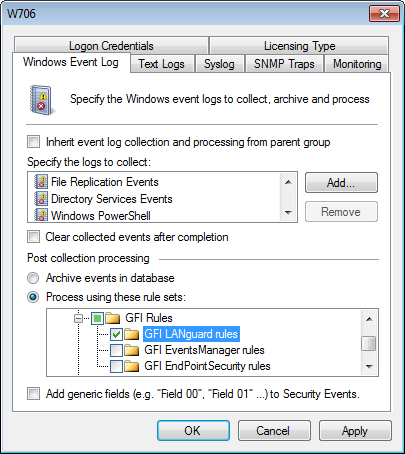Collecting GFI LanGuard event logs
GFI EventsManager enables you to monitor events generated by GFI LanGuard. GFI LanGuard is a network vulnerability scanner that audits your network for weaknesses that can be exploited by users for malicious purposes. During network audits, GFI LanGuard creates events in the ‘Application Log’ of the machine where it is installed.
For each machine scanned by GFI LanGuard, an ‘Application log’ entry having ‘Event ID: 0’ and ‘Source’ set as GFI LanGuard will be generated. These events denote network vulnerability information extracted from scanned computers including:
Note
For more information about GFI LanGuard, refer to https://www.gfi.com/network-security-vulnerability-scanner.
Note
GFI EventsManager can process events generated by GFI LanGuard version 9.5 or later.
How to enable GFI LanGuard event logging?
There are two key steps needed to enable event log integration between GFI LanGuard and GFI EventsManager:
Step 1: Enable GFI LanGuard logging
To enable GFI LanGuard to output event logs on completion of system audits:
1. Add the machine where GFI LanGuard is installed as an event source.
2. Click Start > Run and key in regedit. Press Enter.

Enabling GFI LanGuard logging through the registry
3. Go to the following registry key and edit the value to enable event logging:
- Windows® x86 platforms:
- HKEY_LOCAL_MACHINE\SOFTWARE\GFI\LNSS[n]\Config
- Set value of REG_DWORD EventLog to 1
- Windows® x64 platforms:
- HKEY_LOCAL_MACHINE\SOFTWARE\Wow6432Node\GFI\LNSS[n]\Config
- Set value of REG_DWORD EventLog to 1
Important
[n] is the major version number of GFI LanGuard.
Example: HKEY_LOCAL_MACHINE\SOFTWARE\GFI\LNSS9\Config\EventLog = 1(dword)
Note
To stop GFI LanGuard from generating ‘Application Log’ entries, remove the registry value described above or change the registry value to 0.
Step 2: Configure GFI EventsManager to collect Application logs
GFI LanGuard outputs windows event logs to the ‘Application Log’ category. Ensure that the collection of Application logs is enabled on the GFI LanGuard event source.
To enable processing of GFI LanGuard events:
1. Open GFI EventsManager Management Console.
2. Click Configuration tab > Event Sources.
3. Right-click on the GFI LanGuard event source and select Properties.

Add Windows® Application logs
4. From Windows® Event Log tab, click Add and select Windows® Logs. Click OK.

Add GFI LanGuard rules
5. Select Process using these rule sets. Expand Windows Events > GFI Rules node and select GFI LanGuard rules.
6. Click OK.
Note
GFI EventsManager has built-in processing rules for GFI LanGuard events that are enabled by default. To monitor events generated by GFI LanGuard, select Status tab > General and locate the Critical and High Importance Events section.
Note
To configure GFI LanGuard event processing rules, click Configuration tab > Event Processing Rules. From the left pane select GFI Rules > GFI LanGuardrules. For more information refer to Events Processing Rules.
Testing and troubleshooting
To check if GFI LanGuard events are being generated:
1. Open GFI LanGuard and run a security audit scan on the localhost.
2. When the scan finishes, open Event Viewer from Start > Run and key in eventvwr. Press Enter.
3. Go to Event Viewer (local) Windows Logs Application.
4. Once the stored events are loaded, search for an entry with:
- Source: GFI LanGuard
- Event ID: 0.
In case the event log is not created, typically the GFI LanGuard scan was already initiated once the registry key to output event logs was modified. Re-run the scan. Alternatively ensure that the registry value was created in the right location as the location for x86 platforms is different from that of x64 platforms.